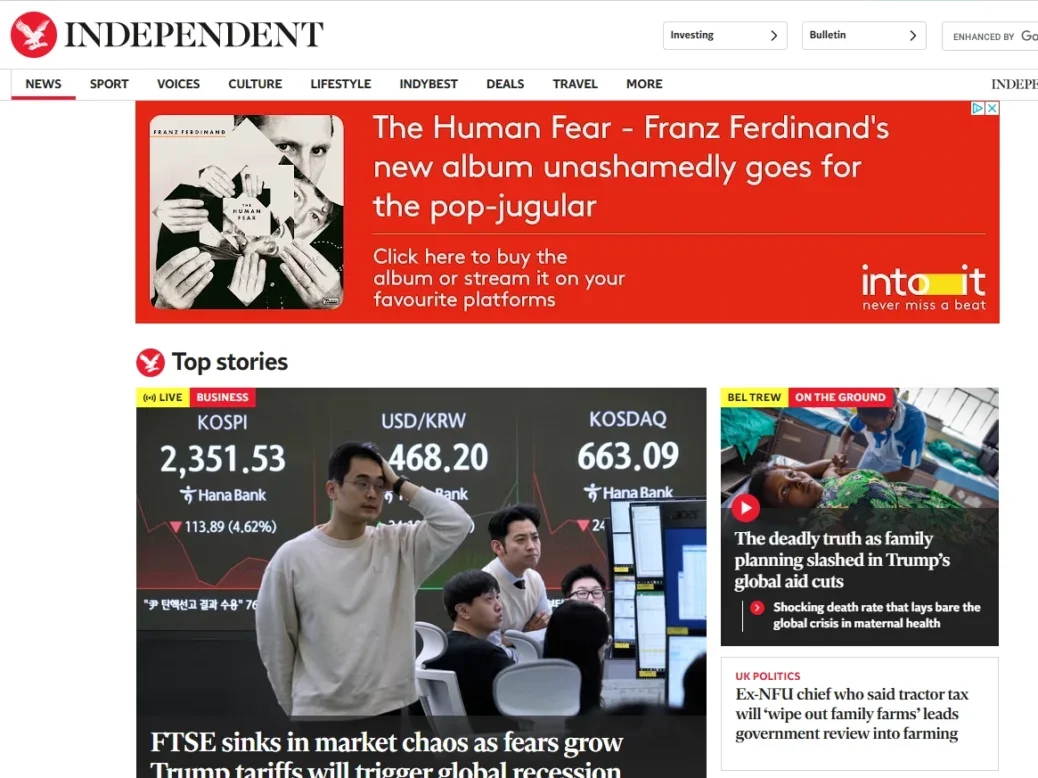
The Independent’s commercial director has described working with a browser extension that will show opted-in users advertising related to their music tastes as a “no brainer”.
Users who download Into-It onto their browser and tell it what music artists and genres they like will see some personalised banner adverts on The Independent and The Guardian which are trialling the tool.
The ads, which might tell users about concert dates, album launches or merchandise for artists they like, are designed to help music companies like record labels, music festivals and vinyl shops target a highly engaged audience who have actively said they are interested.
The Independent’s commercial director Oli Wheatley told Press Gazette it was a “no brainer” to try out the new programmatic tech, which “fits quite seamlessly into our programmatic ecosystem – it doesn’t require any extra code on page or anything like that”.
Wheatley already knew Into-It’s founder Lee Henshaw, who ran advertising company Silence Media before selling it in 2023 to sales house Canopy Media, which does regional sales for The Independent. He said when he first heard about Into-It he “loved how innovative it was, how pioneering it was”.”
‘Frustration’ around advertising on The Independent music content
Wheatley said Into-It also fits with The Independent’s strength in the music vertical, for which it gets about two million unique users a month.
The Independent partners with several music festivals including The Great Escape in Brighton and Bilbao BBK Live in Spain. It also runs an occasional live music series called Music Box and music editor Roisin O’Connor has recently launched a podcast interviewing music artists from soul artist Nao to film composer Hans Zimmer.
Wheatley said it has been “a frustration over the last few years” because despite audiences staying strong, advertisers in categories like music have increasingly shifted away from news publishers towards social media platforms.
Wheatley said Into-It was therefore “a potential way of reclaiming some of that music readership that we’ve missed out on” with advertisers.
He added that Into-It is aimed at a slightly older audience, over-30s rather than 18 to 24-year-olds, which fits with The Independent’s average age which is around 44.
Studies have found that most people stop listening to new music in their early 30s which Wheatley suggested could at least in part be attributed to people settling down with children instead of going out to gigs.
“So this is quite a good way of keeping people up to date on the things that they want to be updated on, and the artists and the genres that they love… in a really consensual, premium way.”
How to get people to download a browser extension?
Some of the best-known uses for browser extensions are spelling and grammar checkers, like Grammarly, and coupon searchers, which can find and automatically apply discount codes to online shopping baskets.
People need to find and download extensions to their browsers, whether they use Chrome, Firefox, Safari or a smaller name, but once they are activated they work in the background. Into-It currently only works on desktop/laptop browsers, not mobile.
Getting people to the download stage is “100% the big challenge with any browser extension,” Wheatley acknowledged. “If everyone in the world downloaded it, then it would be brilliant, but it’s getting them to download it in the first place.”
He said The Independent will be using ad space and editorial traffic drivers like weekly music newsletter Now Hear This to plug the extension and tell people what they’ll get out of it.
Music advertisers will still have to bid for the ad slots on The Independent’s site, so a retailer selling Kendrick Lamar could be up against a broadband provider.
Wheatley suggested the music companies have bought into the idea because “it’s a way of them getting far deeper engagement with their audience and their fanbase of the various artists,” noting that this may be enough for them to pay a higher CPM for it against all of the other programmatic bids in The Independent’s ecosystem.
Music chain Rough Trade’s paid search and acquisition manager Charlie Sinclair-Sanders said they put value on “authentic connections with music fans” while We Out Here Festival’s marketing manager Josh Aitman said Into-It is a ” powerful new channel to reach fans specifically interested” in their artists “when they’re browsing their favourite news sites, while letting us test different messaging around our ticket options to see which resonates best with potential festival-goers”.
Into-It ads will also be frequency capped, meaning no artist will target a user more than 14 times in a week so audiences don’t get overwhelmed and it doesn’t feel “too intrusive”, Wheatley said.
Asked how The Independent will know if Into-It is helping, Wheatley said simply: “The proof in the pudding will just be if money starts coming through the pipes… by the very nature of it, the money will start small, and it should grow.”
He added: “But with all these things, you just have to try something new and give it a chance. Otherwise, you were doing the same things over again and not succeeding that way.”
The launch was backed by Association of Online Publishers managing director Richard Reeves who said: “By enhancing the user experience while creating new commercial opportunities for publishers and the music industry, this technology offers a fresh approach to digital engagement. The collaborative approach they’ve taken, working closely with publishers to establish best practices, is exactly the kind of partnership model we need to see more of in the digital ecosystem.”
Email pged@pressgazette.co.uk to point out mistakes, provide story tips or send in a letter for publication on our "Letters Page" blog
